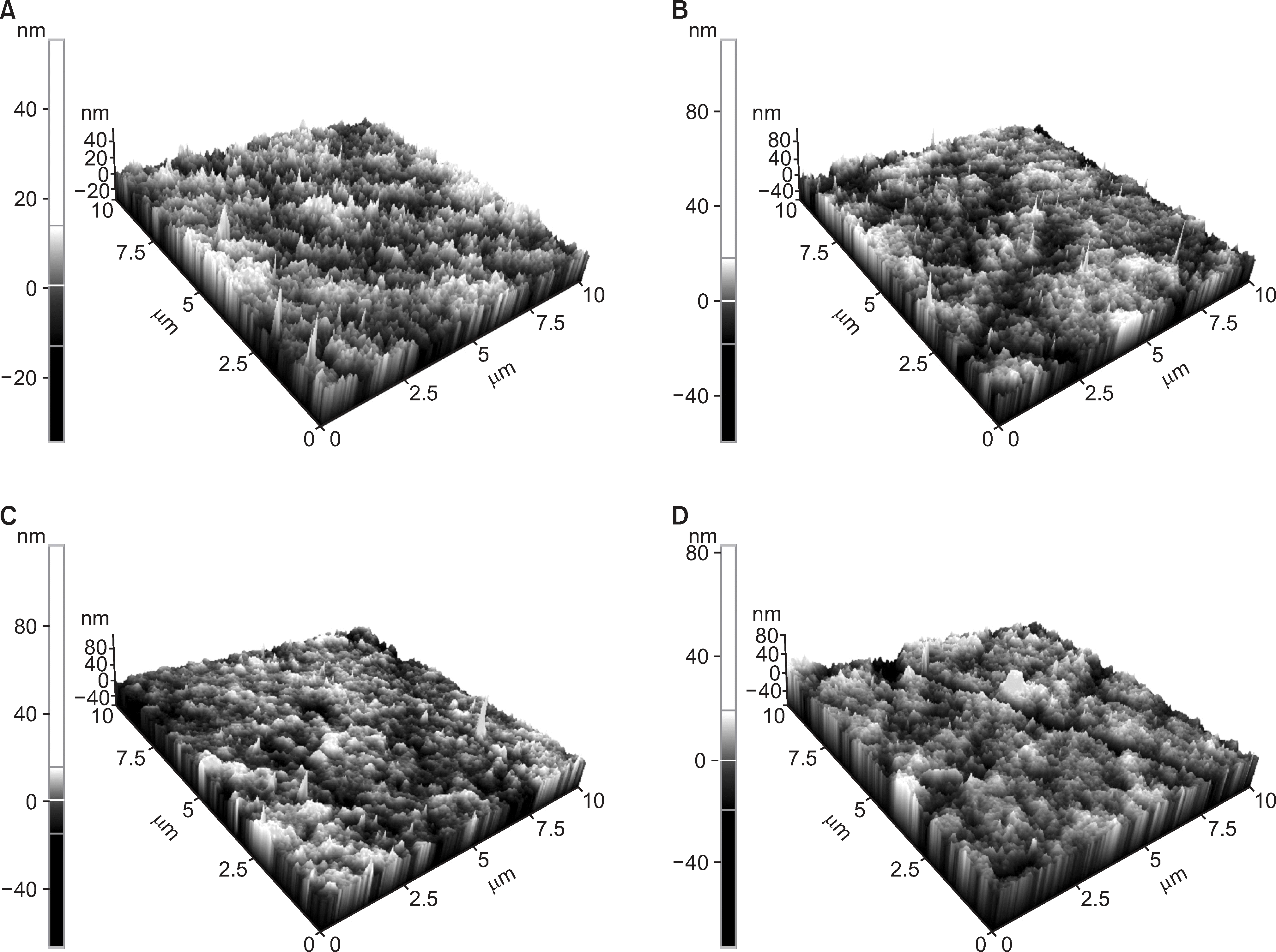Abstract
Objectives
We compared the effects of a 1,500 ppm fluoride-containing toothpaste and a 1,000 ppm fluoride-containing toothpaste, which were revised up to the recent revision, and evaluated their effects on the tooth surface after adding bamboo salt to the preparations.
Methods
Experimental early artificial caries specimens were subjected to one of four treatments (n=12 per treatment group): 1,500 ppm NaF, 2% bamboo salt+1,000 ppm NaF, 1,000 ppm NaF, and control treatment. The specimens were exposed to the experimental toothpaste, artificial saliva, and demineralized solution. The treated specimens were analyzed using Vickers surface hardness testing, scanning electron microscopy, and atomic force microscopy.
Results
The toothpaste with a high fluoride concentration (1,500 ppm NaF) showed more remineralization than did the toothpaste with a low fluoride concentration (1,000 ppm NaF). The 2% bamboo salt+1,000 ppm NaF group showed remineralization similar to the 1,500 ppm NaF group and higher surface microhardness than the 1,000 ppm NaF group.
Go to : 
References
1. World Health Organization. Report of a WHO Expert Committee on oral health status and fluoride use. Geneva: World Health Organiza-tion;1994. p. 1–37.
2. Shani Ann Mani. Evidence-based clinical recommendation for fluoride use : a review. Arch Orofac Sci. 2009; 4:1–6.
3. Horowitz HS. The 2001 CDC recommendations for using fluoride to prevent and control dental caries in the United States. J Public Health Dent. 2003; 63:3–8.

4. Marinho VC, Higgins JP, Sheiham A, Logan S. Combinations of topical fluoride (toothpastes, mouthrinses, gels, varnishes) versus single topical fluoride for preventing dental caries in children and adolescents. Cochrane Database Syst Rev. 2004; (1). CD002781.

5. FDI World Dental Federation. Promoting dental health through fluoride toothpaste 2008. Stockholm: FDI World Dental Federation;2008.
6. Murry JJ, Rugg-Gunnn AJ. Fluorides in caries prevention. 2nd ed. Bristol: John Wright & Sons;1982. p. 101–121.
7. Ministry of food and drug safety. Medicines etc standard manufacturing standards some revision notices(011-37). Cheongju: Ministry of Food and Drug Safety;2011. p. 1–24.
8. Kim JH, Jeong SS, Choi CH, Hong SJ. Fluoride concentration of commercial dentifrices and effect of fluoride containing dentifrices on artificial enamel caries. J Korean Acad Oral Health. 2006; 30:56–66.
9. FDA 21 CFR Parts 310, 355 and 369 Anticaries drug products for over-the- counter human use; Final monograph. Feder Reg. 1995; 60:52474–52510.
10. Korea health promotion foundation. What’s in the toothpaste? Tooth decay prevention? seoul: Korea health promotion founda-tion;2016. p. 1–4.
11. Europäische Kommission Scientific Committee on Cosmetic Products and Non-Food Products. Opinion of the Scientific Committee on Cosmetic Products and Non-Food Products Intended for Con- sumers: The safety of fluorine compounds in oral hygiene products for children under age of 6 years. SCCNFP 24th plenary meet-ing. 2003. 1–26.
12. Ministry of Food and Drug Safety. Medicines etc Standard manufacturing standards Some revision notices(014-152). Cheongju: Ministry of Food and Drug Safety;2014. p. 1–9.
13. Ha MO. The effect of bamboo salt on remineralization of subsurface of incipient caries enamel [master’s thesis]. Gwangju: Chonnam National Uni- versity;2016. [Korean].
14. Bibby BG. A test of the effect of fluoride-containing dentifrices on dental caries. J Dent Res. 1945; 24:297–303.

15. Marthaler TM1, O’Mullane DM, Vrbic V. The prevalence of dental caries in Europe 1990-1995. ORCA Saturday afternoon symposium 1995. Caries Res. 1996; 30:237–255.
16. White DJ. Reactivity of fluoride dentifrices with artificial caries II. Effect on subsurface lesions: F uptake, F distribution, surface hardening and remineralization. Caries Res. 1988; 22:27–36.
17. Damato FA, Stephen KW KW, Edgar WM. In situ remineralization studies using SMFP and NaF dentifrices. JDR. 1994; 73:(Abstr). 272.
19. Kwon JH, Park HW, Lee JH, Seo HW. The analysis of remineralization effect in fluoride varnish using confocal laser scanning mi-croscpoe. J Korean Acad Pediatr Dent. 2008; 35:57–64.
20. Davies GM, Worthington HV, Ellwood RP, Bentley EM, Blinkhorn AS, Taylor GO, et al. A randomised controlled trial of the effectiveness of providing free fluoride toothpaste from the age 12 months on reducing caries in 54-year old children. Community Dent Health. 2002; 19:131–136.
21. Ha MO, Choi CH, Youn HJ, Hong SJ. The effect of dentifrice containing bamboo salt on the acid resistance of enamel. J Korean Acad Oral Health. 2010; 34:482–490.
Go to : 
 | Fig. 1.SEM images of bovine teeth surface after treatment (A: 1,500 ppm NaF, B: 1,000 ppm NaF+2% BS, C: 1,000 ppm NaF, D: free fluoride, 1: ×50,000, 2: ×100,000). |
 | Fig. 2.AFM images of bovine teeth surface after treatment (A: 1,500 ppm NaF, B: 1,000 ppm NaF + 2% BS, C: 1,000 ppm NaF, D: free fluoride). |
Table 1.
Test groups for the study
| Group | Fluoride | Bamboo salt | Abrasive |
|---|---|---|---|
| 1 | 1,500 ppm NaF | - | |
| 2 | 1,000 ppm NaF | 2% | Silica |
| 3 | 1,000 ppm NaF | - | |
| 4 | Free | - |
Table 2.
Time table for treatment solution and artificial saliva cycle for the period of 15 days
| Time | Treatment |
|---|---|
| 09:00-09:03 | Treatment Solution (Dentifrice) |
| 09:03-11:00 | Artificial Saliva* |
| 11:00-11:03 | Treatment Solution (Dentifrice) |
| 11:03-14:00 | Artificial Saliva |
| 14:00-17:00 | Demineralizing Solution† |
| 17:00-17:03 | Treatment Solution (Dentifrice) |
| 17:03-Next morning | Artificial Saliva |
Table 3.
Effects of the different dentifrices on lesion surface hardness according to chemical cycling methods (unit: VHN)
| Group | N |
Treatment |
Difference* | |
|---|---|---|---|---|
| Before (0 day) | After (15 day) | (△VHN) | ||
| 1,500 ppm NaF | 12 | 36.57±5.19 | 146.94±14.16 | 110.36±15.26a |
| 1,000 ppm NaF+2% BS | 12 | 36.70±5.00 | 141.33±12.49 | 104.63±13.23a,b |
| 1,000 ppm NaF | 12 | 36.68±4.94 | 130.88±17.45 | 94.19±15.95b |
| Free Fluoride | 12 | 36.72±4.79 | 55.54±3.87 | 18.82±4.71c |




 PDF
PDF ePub
ePub Citation
Citation Print
Print


 XML Download
XML Download